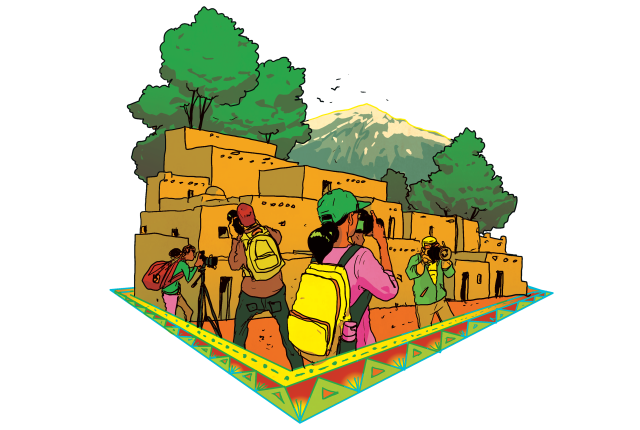EVEN IN A TOWN AS STORIED IN ART and history as Taos, the Mabel Dodge Luhan House stands out. For years, it has maintained its origins as a nearly 100-year-old salon and retreat for artists to discover the magic of northern New Mexico while developing their creative skills. The historic inn currently hosts around 30 workshops annually, drawing instructors from throughout the country to teach small classes on photography, painting, paper collage, and yoga.
I catch a guest pass one breezy day in late summer, as photographer Harvey Stein leads eight students on a day trip from Taos to Las Vegas, New Mexico, to shoot portraits on and around the small city’s historic plaza. The road trip is one of a handful planned by Stein, who’s taught weeklong August workshops at the Luhan House for more than 15 years.
Under the shade of an old cottonwood, the native New Yorker urges the group to interact with strangers. “People are really friendly here,” he says encouragingly. “Talk to them. Get a feel for the place.”
The students look intently at the grassy plaza, a filming location for productions like Red Dawn and Longmire. A vintage race car, whose back seat appears to have morphed into a gigantic golden teddy bear, makes its way toward us. The grinning driver slows and waves, granting permission to the cluster of photographers focusing their lenses on him.
“Make sure to explore the plaza’s shops,” Stein says. “There’s a pharmacy around the corner that looks like it’s still operating in the 1950s. If the cowboy boot store is open today, you have to check it out.”
The directives are just enough to set curious shutterbugs in motion. They head into antique stores, study the impressive facade of the long-closed Navajo Textiles parachute factory, and admire the turn-of-the-century elegance of the Plaza Hotel. Lunch is at El Rialto, a restaurant just off the plaza that serves classic norteño fare like tamales, stuffed sopaipillas, and rainbow trout.
For many of the students, it’s an ideal artistic—and quintessentially New Mexico—experience. Manhattanite Marjorie Gurd immediately pinpoints what has drawn artists to the Southwest for more than a century. “It’s the light, of course,” she says while adjusting her camera’s aperture to focus on a nearly 13-foot-tall wooden sculpture of the Virgen de Guadalupe. “You don’t get light like this in New York.”
For Robert and Linda Pinto, a husband and wife from Las Cruces, the opportunity to learn the finer points of photography proved irresistible. “It’s nice to be able to display your own artwork in your home,” says Linda. “And it’s fun to see parts of our state I’m not as familiar with.”
Read more: In Roswell, an intro pottery class offers infinite chances for creativity—and calm.
Stein has taught at the International Center of Photography, on Manhattan’s Lower East Side, since 1976. He first visited New Mexico in the mid-1980s and fell in love with its creative potential. For him, the state’s photographic allure offers a complete aesthetic departure from the East. “The uniqueness of Mabel Dodge Luhan and the inn’s history is a draw,” says Stein. “The location in Taos allows us to drive to spectacular places within a few hours’ time.”
Visitors attending creative workshops tend to become just as absorbed by the house’s unique past and beautiful grounds and interiors. In 1917, Mabel Dodge Luhan famously left high-society New York for Taos, where she regularly hosted a luminous network of artists and writers. She purchased the property in the 1920s at the urging of her husband, Tony Lujan, who came from Taos Pueblo, and got to work remodeling it and expanding it. The property was bought by actor Dennis Hopper in 1970 before switching ownership again. Eventually it was purchased by the Attiyeh Foundation, which has operated it as a hotel and conference center since 1996.
Today, the quarters include 21 rooms, each named for special guests. Workshop meals are provided on-site, with an emphasis on local produce and New Mexico classics.
Program coordinator Vanessa Fortin says Taos complements the workshop experience. “You can explore endlessly here, filling your entire day with activities far beyond gallery hopping,” she says, indicating the expansive land surrounding the house, which manages to feel somewhat isolated despite its proximity to the center of town. Its piñon-dotted foothills lead to Taos Pueblo, visible from many of the inn’s rooms.
What you won’t find are televisions, which helps to facilitate artistic contemplation. When guests gather in the elegant, art-filled dining room for breakfast or dinner, it’s easy to feel a part of a long legacy of hospitality. As Luhan wrote in her 1935 memoir, Winter in Taos, “The house is always full of people and we rarely sit down to dinner with fewer than six or eight at the table, and the same happens often unexpectedly for lunch, people arriving from all over the world.”
Schedule a retreat at mabeldodgeluhan.com.


